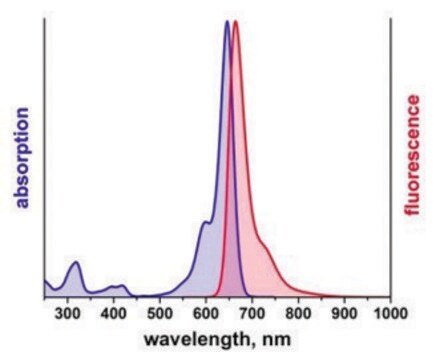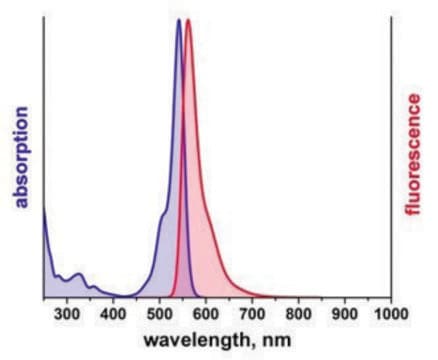推薦產品
產品線
Duolink®
品質等級
技術
proximity ligation assay: suitable
螢光
λex 360 nm; λem 460 nm
適合性
suitable for fluorescence-detection automated sequencing
suitable for microtiter plates
運輸包裝
dry ice
儲存溫度
−20°C
應用
Duolink®proximity ligation assay(PLA®) allows for endogenous detection of protein interactions, post translational modifications, and protein expression levels at the single molecule level in fixed cells and tissue samples.
Use the Multiwell Plates modifications to the Duolink® In Situ Fluorescence Protocol to run an experiment with this product. A set of short instructions can also be used.
Visit our Duolink® PLA Resource Center for information on how to run a Duolink® experiment, applications, troubleshooting, and more.
To perform a complete Duolink® PLA in situ experiment you will need two primary antibodies (PLA, IHC, ICC or IF validated) that recognize two target epitopes. Other necessary reagents include a pair of PLA probes from different species (one PLUS and one MINUS), detection reagents, wash buffers, and mounting medium. Note that the primary antibodies must come from the same species as the Duolink® PLA probes. Analysis is carried out using standard immunofluorescence assay equipment.
Use the Multiwell Plates modifications to the Duolink® In Situ Fluorescence Protocol to run an experiment with this product. A set of short instructions can also be used.
Visit our Duolink® PLA Resource Center for information on how to run a Duolink® experiment, applications, troubleshooting, and more.
To perform a complete Duolink® PLA in situ experiment you will need two primary antibodies (PLA, IHC, ICC or IF validated) that recognize two target epitopes. Other necessary reagents include a pair of PLA probes from different species (one PLUS and one MINUS), detection reagents, wash buffers, and mounting medium. Note that the primary antibodies must come from the same species as the Duolink® PLA probes. Analysis is carried out using standard immunofluorescence assay equipment.
Specificity
Duolink® In Situ Microplate Nuclear Stain and Anti-Fade are intended to be used after staining cells with Duolink® In Situ in microtiter plates. See the datasheet for more information.
Application Note
Two primary antibodies raised in different species are needed. Test your primary antibodies (IgG-class, mono- or polyclonal) in a standard immunofluorescence (IF), immunohistochemistry (IHC) or immunocytochemistry (ICC) assay to determine the optimal fixation, blocking, and titer conditions. Duolink® in situ reagents are suitable for use on fixed cells, cytospin cells, cells grown on slide, formalin-fixed, paraffin embedded (FFPE), or tissue (fresh or frozen). No minimum number of cells is required.
Let us do the work for you, learn more about our Custom Service Program to accelerate your Duolink® projects
View full Duolink® product list
Duolink® In Situ Microplate Nuclear Stain and Anti-Fade are intended to be used after staining cells with Duolink® In Situ in microtiter plates. See the datasheet for more information.
Application Note
Two primary antibodies raised in different species are needed. Test your primary antibodies (IgG-class, mono- or polyclonal) in a standard immunofluorescence (IF), immunohistochemistry (IHC) or immunocytochemistry (ICC) assay to determine the optimal fixation, blocking, and titer conditions. Duolink® in situ reagents are suitable for use on fixed cells, cytospin cells, cells grown on slide, formalin-fixed, paraffin embedded (FFPE), or tissue (fresh or frozen). No minimum number of cells is required.
Let us do the work for you, learn more about our Custom Service Program to accelerate your Duolink® projects
View full Duolink® product list
特點和優勢
- No overexpression or genetic manipulation required
- High specificity (fewer false positives)
- Single molecule sensitivity due to rolling circle amplification
- Relative quantification possible
- No special equipment needed
- Quicker and simpler than FRET
- Increased accuracy compared to co-IP
- Publication-ready results
法律資訊
Duolink is a registered trademark of Merck KGaA, Darmstadt, Germany
PLA is a registered trademark of Merck KGaA, Darmstadt, Germany
訊號詞
Warning
危險聲明
危險分類
Aquatic Chronic 3 - Skin Sens. 1
儲存類別代碼
12 - Non Combustible Liquids
閃點(°F)
Not applicable
閃點(°C)
Not applicable
客戶也查看了
Charles Lu et al.
PloS one, 7(4), e34833-e34833 (2012-05-05)
Tumor suppressor gene TUSC2/FUS1 (TUSC2) is frequently inactivated early in lung cancer development. TUSC2 mediates apoptosis in cancer cells but not normal cells by upregulation of the intrinsic apoptotic pathway. No drug strategies currently exist targeting loss-of-function genetic abnormalities. We
Jeffrey J Raizer et al.
Cancer, 116(22), 5297-5305 (2010-07-29)
The authors evaluated a 3-week schedule of bevacizumab in patients with recurrent high-grade glioma (HGG). Patients received bevacizumab 15 mg/kg every 3 weeks and were evaluated every 6 weeks until tumor progression. Tissue correlates were used to quantify tumor content
Jaclyn J Renfrow et al.
Neuro-oncology, 13(8), 880-885 (2011-07-30)
We present a novel methodology combining traditional fluorescent in situ hybridization with an in situ protein detection technology called proximity ligation assay. This method has potential to perform a detailed analysis of the relationship between gene status and corresponding protein
Thomas W Bonagura et al.
Endocrinology, 153(6), 2897-2906 (2012-04-13)
We previously showed that advancing the increase in estradiol levels from the second to the first third of baboon pregnancy suppressed placental extravillous trophoblast (EVT) invasion and remodeling of the uterine spiral arteries. Cell culture studies show that vascular endothelial
Yukiko Hasumi et al.
Proceedings of the National Academy of Sciences of the United States of America, 106(44), 18722-18727 (2009-10-24)
Germline mutations in the BHD/FLCN tumor suppressor gene predispose patients to develop renal tumors in the hamartoma syndrome, Birt-Hogg-Dubé (BHD). BHD encodes folliculin, a protein with unknown function that may interact with the energy- and nutrient-sensing AMPK-mTOR signaling pathways. To
文章
Find Duolink references based on the type of method used, post translational modification detected, and research focus.
條款
Duolink® PLA Multicolor Detection Protocol
Global Trade Item Number
| 庫存單位 | GTIN |
|---|---|
| DUO82064-1KT | 4061833591932 |
我們的科學家團隊在所有研究領域都有豐富的經驗,包括生命科學、材料科學、化學合成、色譜、分析等.
聯絡技術服務















